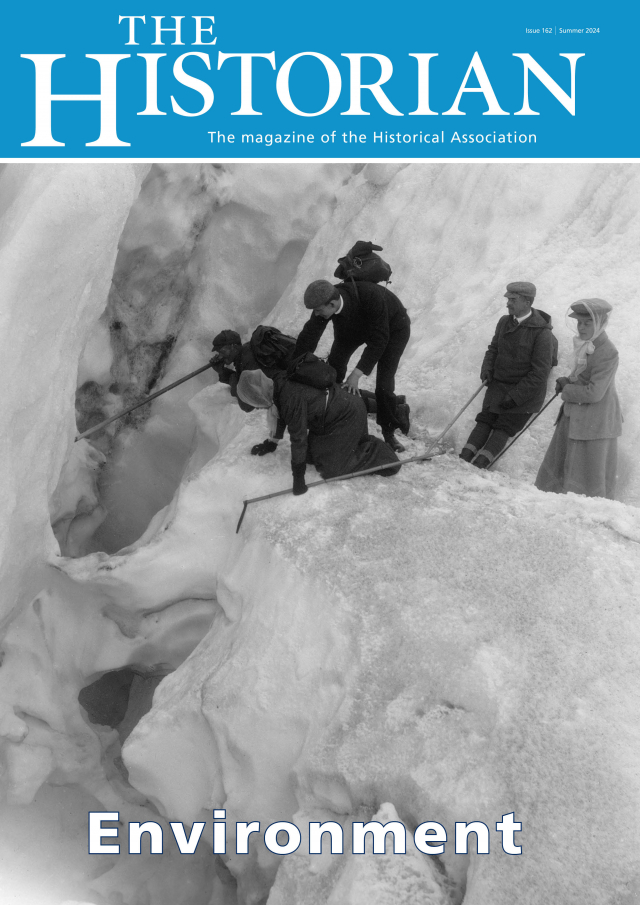The Historian 162: Out now
The magazine of the Historical Association

Editorial: Environment
Read The Historian 162: Environment
Environment, broadly defined as the surroundings in which one lives, is an essential component of the study of past societies. Its importance has given rise to a number of fields of study. In Britain, landscape history was pioneered by W.G. Hoskins in the 1950s, and has explored the impact of human activity on the evolution of the countryside. Urban history expanded significantly in the 1960s, when historians became interested in the development and management of towns and cities. Environmental history is a larger, more encompassing field in which historians have explored the entanglement between humans and the natural world as they have changed over time.
As Amanda Power demonstrates in her article for this issue, growing awareness of the current climate crisis has given environmental history a ‘new prominence’. In recent years, historians have teamed up with a range of specialists in other disciplines – Power points to ‘archaeologists, palaeoclimatologists, palaeobotanists, earth scientists, anthropologists’ and more – to study environments of the past. Working with natural scientists has given historians access to new data; at the same time, historical perspectives have informed how researchers understand human responses to environmental change. Particularly striking, as Power explains, is the way in which well-known events, such as the accounts of water miracles in sixteenth-century Italy, have been reconceptualised as a result of new evidence of important changes in the natural world – in this case, a period of unusually high rainfall.
While this is an excellent example of the direct impact of the environment on human society and culture, environmental history often remains concerned with the impact of human activity on the natural world.
In their article, Carla Benzan and Samuel Shaw explain how they are using artworks and objects from collections in galleries and museums to bring environmental history to new audiences largely through the medium of film. Seemingly unrelated artefacts – skins, skulls and portraits of polar bears in Scottish museums – when placed alongside each other, can reveal new insights into humans’ interactions with the natural world in the past, while encouraging us to reconsider our practices in the present. Christian Drury’s article takes us to the arctic, and explains the rise of glacier tourism from the mid-nineteenth to the early twentieth century. It is a superb example of the desire of humans across time and space to experience the wonders of the natural world, in this case the awe-inspiring glaciers of Norway, in the process reshaping the landscape through the construction of hotels, railways and other paraphernalia of a tourist industry.
Towns and cities are environments largely created by humans. In their article, Lucy Faire and Denise McHugh use citizen testimony from oral histories, autobiographies, vox pops and recollections posted on social media platforms to recover the sensory experience of the mid-twentieth century urban environment, specifically the sights, smells and sounds generated by human activity. Yet even the most established and heavily developed population centres remain somewhat subservient to their natural surroundings. In our first ‘Doing History’ article, Hannah Worthen and Briony McDonagh provide an account of their use of medieval and early modern sources on flood and water management in Hull to engage present-day communities in conversations about flood risk. We warmly invite future contributions for this section from readers and other local or community historians who are ‘doing history’ – we are looking for engaging, informative and educational pieces on collections of sources or specific projects which could inspire others who are working on or thinking about doing their own projects.
Moving away from our theme, we are delighted to include in this issue further contributions on a range of exciting topics. Martyn Whittock reviews the evidence – both textual and archeological – of interactions between the Norse and First Peoples of America in the eleventh and twelfth centuries. Derek Ying looks at the little-known attempts to create a national anthem in China between the 1880s and the 1930s. Adrian Smith introduces us to a largely forgotten figure of French History, Georges Thierry d’Argenlieu, an ordained priest and naval officer who played a pivotal role in the Resistance as co-founder of the Free French Navy in the summer of 1940. The theme of war continues in our ‘Real Lives’ section, as Asim Shah, recipient of the Young Historian GCSE World War One Essay Prize, provides an account of Henry Allingham’s service in the Royal Naval Air Service to demonstrate that the contributions of every serviceperson made a difference. And finally, in ‘My Favourite History Place’, Julia Dean takes us to Bad Godesberg Tower in Bonn, Germany.
As newcomers to The Historian editorial board, we have thoroughly enjoyed working on our first issue of the journal. We hope that you enjoy reading and engaging with it, and we warmly welcome your feedback.

